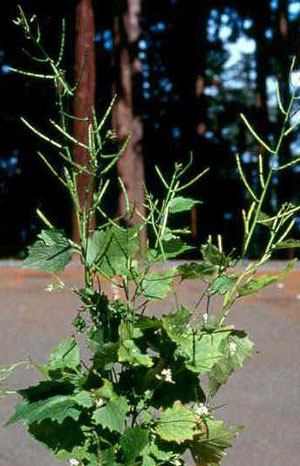It’s spring! The snow has finally melted, the birds are singing, the bulbs are starting to bloom and the lawn will soon be turning green. Wait….. what’s that? Are those weeds in my lawn and flower beds? How did they get there? This is something that we all run into. It seems that every year, no matter how diligent we are, some little weeds pop right up. Technically speaking, a weed is just a plant out of place, but how do you distinguish between a weed and your emerging perennials? We’ve detailed two of the most common spring weeds in this article to help with that distinction. Happy weeding.
 Garlic Mustard (Alliaria petiolata) is a biennial plant, meaning it has a two-year life cycle. First year plants do not produce blooms, but can be easily identified by their leaves. They have clusters of 3-8 rounded to kidney shaped leaves growing at ground level. The leaves have scalloped edges, a wrinkled appearance, and remain green all winter. In spring and early summer, the leaves emit a distinct garlic or onion odor when crushed. By the second year, plants start to produce stalks of small white flowers beginning in April and continuing through June. Growing about 1-4 feet tall, garlic mustard tends to be the only weed with this height and color that is blooming this time of the year, which helps in its identification. Elongated seed capsules appear soon after flowering and quickly lengthen. The seeds are small, produced in a row inside the capsule, and turn black when ripe. They have more than 100 seeds per plant.
Garlic Mustard (Alliaria petiolata) is a biennial plant, meaning it has a two-year life cycle. First year plants do not produce blooms, but can be easily identified by their leaves. They have clusters of 3-8 rounded to kidney shaped leaves growing at ground level. The leaves have scalloped edges, a wrinkled appearance, and remain green all winter. In spring and early summer, the leaves emit a distinct garlic or onion odor when crushed. By the second year, plants start to produce stalks of small white flowers beginning in April and continuing through June. Growing about 1-4 feet tall, garlic mustard tends to be the only weed with this height and color that is blooming this time of the year, which helps in its identification. Elongated seed capsules appear soon after flowering and quickly lengthen. The seeds are small, produced in a row inside the capsule, and turn black when ripe. They have more than 100 seeds per plant.
We typically see a few of these plants sprouting up here and there, in which case, they can be pulled by hand. Try to remove the entire plant before or during the blooming period. Although garlic mustard seeds prolifically it is easily pulled by hand. It’s important to remove the plant before the seeds begin to form. Always make sure to discard the weeds in the refuse container, not the compost pile. Even after the plant has been pulled from the ground, the seeds continue to mature. Seeds can lie dormant in the soil for up to 5 years, so continue to check for new weeds to sprout. This is probably why we see them year after year, even with control. There are other options if you need to eradicate a large amount of garlic mustard. Using a weed whip to cut off the tops of the plants before they produce seeds is effective. A chemical control is available in the form of 1-2% active ingredient (a.i.) solution of glyphosate. For best results, follow as directed and apply to the foliage of individual plants and dense patches during early spring. Glyphosate is a non selective herbicide and will kill any plant it is sprayed on, so use it carefully.
 Creeping Buttercup (Ranunculus repens) is a common perennial weed that can grow in moist or dry conditions, creeping buttercup is easily recognized by its shiny yellow blooms. Creeping buttercup blooms from early April until May, and grows about 4 inches tall. It can adapt to become even shorterr in a mowed area. Flowering typically doesn’t occur until the second season, similar to garlic mustard. With shoots that grow quickly, rooting along the way, creeping buttercup can make its presence known in the landscape in a hurry filling the lawn or perennial garden with its bright yellow flowers and shiny leaves. The plant itself only lasts a few months, eventually dying back below ground. The problem is it is so prolific and creates such a root mass that it chokes out other plants and turf.
Creeping Buttercup (Ranunculus repens) is a common perennial weed that can grow in moist or dry conditions, creeping buttercup is easily recognized by its shiny yellow blooms. Creeping buttercup blooms from early April until May, and grows about 4 inches tall. It can adapt to become even shorterr in a mowed area. Flowering typically doesn’t occur until the second season, similar to garlic mustard. With shoots that grow quickly, rooting along the way, creeping buttercup can make its presence known in the landscape in a hurry filling the lawn or perennial garden with its bright yellow flowers and shiny leaves. The plant itself only lasts a few months, eventually dying back below ground. The problem is it is so prolific and creates such a root mass that it chokes out other plants and turf.
Similar to garlic mustard, hand pulling the individual plants is the most common practice if a small amount of this weed is present in your landscape. It is not as easily pulled due to the way it roots along the stems, but this may be the best way to control this plant. Also, similar to garlic mustard, take care in disposal of these plants and stay diligent with hand pulling. The seeds in the soil can germinate up to 5 years later. A chemical approach, using glyphosate in the beds and a weed killer product containing 2,4-D for lawn areas can be somewhat effective, but because it blooms so early the temperatures are not usually conducive to chemical control. With both of these weeds, we really only try to get some control on their spread because eradication is difficult; they are a part of spring and their control is the beginning of the many tasks needed to make a garden look great.
